AUDI Q3 2015 Owners Manual
Manufacturer: AUDI, Model Year: 2015, Model line: Q3, Model: AUDI Q3 2015Pages: 258, PDF Size: 64.9 MB
Page 141 of 258
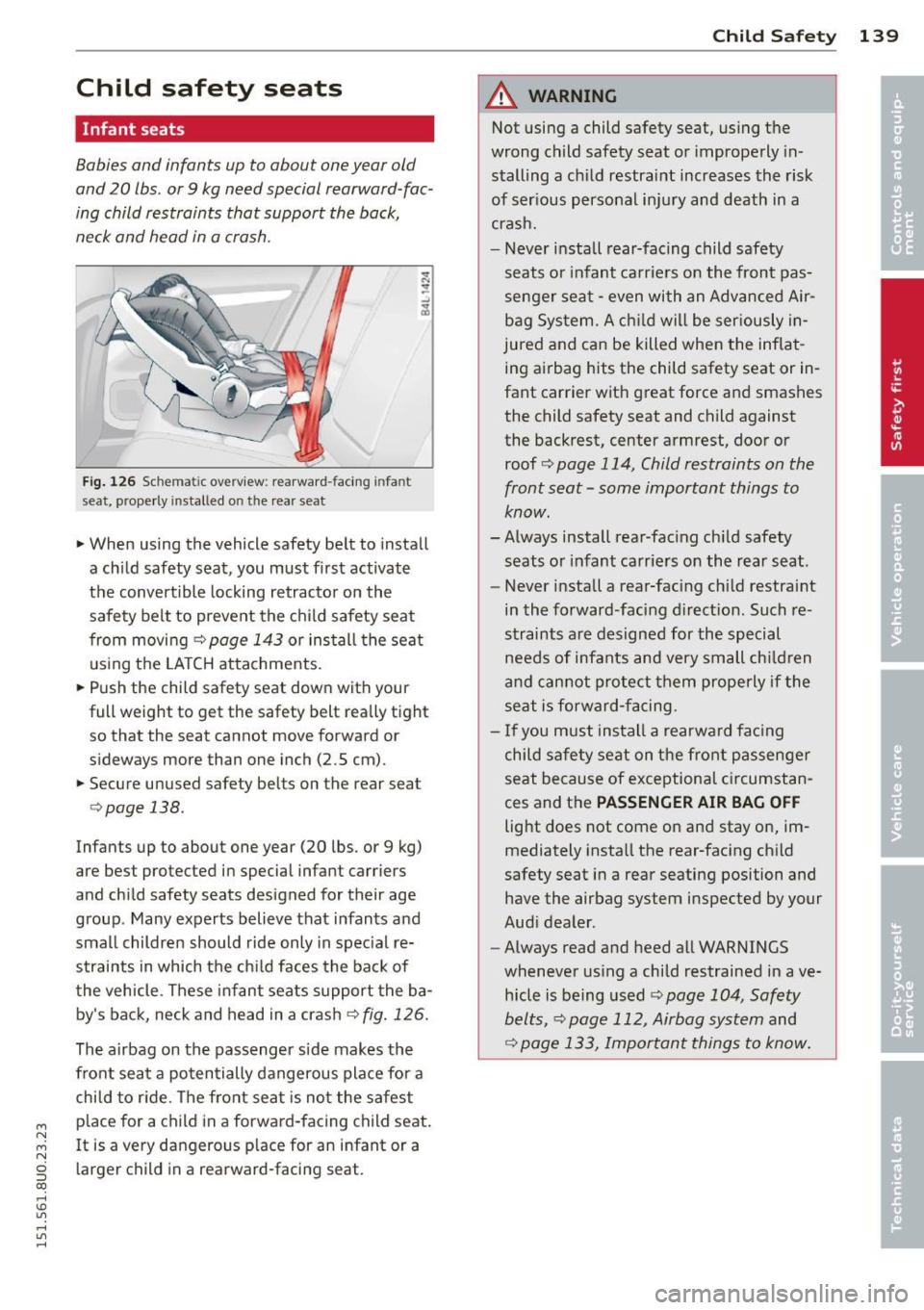
M N M N
0 :::i co
rl I.O
"' rl
"' rl
Child safety seats
Infant seats
Babies and infants up to about one year old
and 20 lbs. or 9 kg need special rearward -fac
ing child restraints that support the back,
neck and head in a crash.
Fig . 126 Sche mati c overv iew: rearward-fac ing infa nt
seat, p roperly installed o n th e rear seat
.,. When using the vehicle safety belt to install
a ch ild safety seat , you must first activate
the convertible locking retracto r on the
safety be lt to prevent the child safety seat
from moving
r=;, page 143 or install the seat
using the LA T CH attachments.
.,. Push the child safety seat down with your
full weight to get the safety belt rea lly tight
so that the seat cannot move forward or
sideways more than one inch (2.5 cm) .
.,. Secure unused safety belts on the rear seat
¢ page 138.
Infants up to about one year (20 lbs . or 9 kg)
are best protected in special infan t carriers
and child safety seats designed for their age
group . Many experts believe that infants and
small children should ride only in spec ial re
straints in which the ch ild faces the back of
the vehicle. These infant seats support the ba
by's back, neck and head in a crash
¢ fig . 126.
The airbag on the passenger side makes the
front seat a po tentially dangerous place for a
child to r ide . The front seat is not the safest
p lace for a child in a forward -facing child seat.
It is a very dangerous p lace for an infant or a
l arger ch ild in a rearward-facing seat.
Child S afety 139
A WARNING
Not using a child safety seat, using t he
wrong child safety seat or improperly in
stall ing a ch ild restraint increases the risk
of ser ious personal injury and death in a
crash.
- Never install rear-facing child safety
seats or infant ca rr ie rs on the front pas
senger seat -even with an Advanced Air
bag Sys tem. A c hild will be ser iously in
jured and ca n be killed when the inflat
ing airbag hits the child safety seat or in
fant carrier with great force and smashes the child safety seat and child against
the backrest, center armrest, door or
roof
r=;, page 114, Child restraints on the
front seat- some important things to
know .
-Always install rear-fac ing ch ild safety
seats or infant carriers on the rear seat .
- Never install a rear-fac ing ch ild restraint
in the forward-fac ing d irect ion. Such re
straints are designed for the special needs of infants and very small ch ild ren
and can not prote ct them properly if the
seat is forward- facing.
- If you mus t insta ll a rearward fa cing
child sa fety seat on the fro nt passenger
seat because of exceptiona l circumstan
ces and t he
PASSENGER AIR BAG OFF
light does not come on and stay on, im
mediately insta ll the rear -fac ing ch ild
safety seat in a rear seating position and have the airbag system inspected by your
Aud i dea ler .
- Always read and heed all WARNINGS
wheneve r us ing a child restrained in ave
hicle is being used
r=;, page 104 , Safety
belts, ,=;,page 112, Airbag system
and
r=;, page 133, Important things to know.
Page 142 of 258
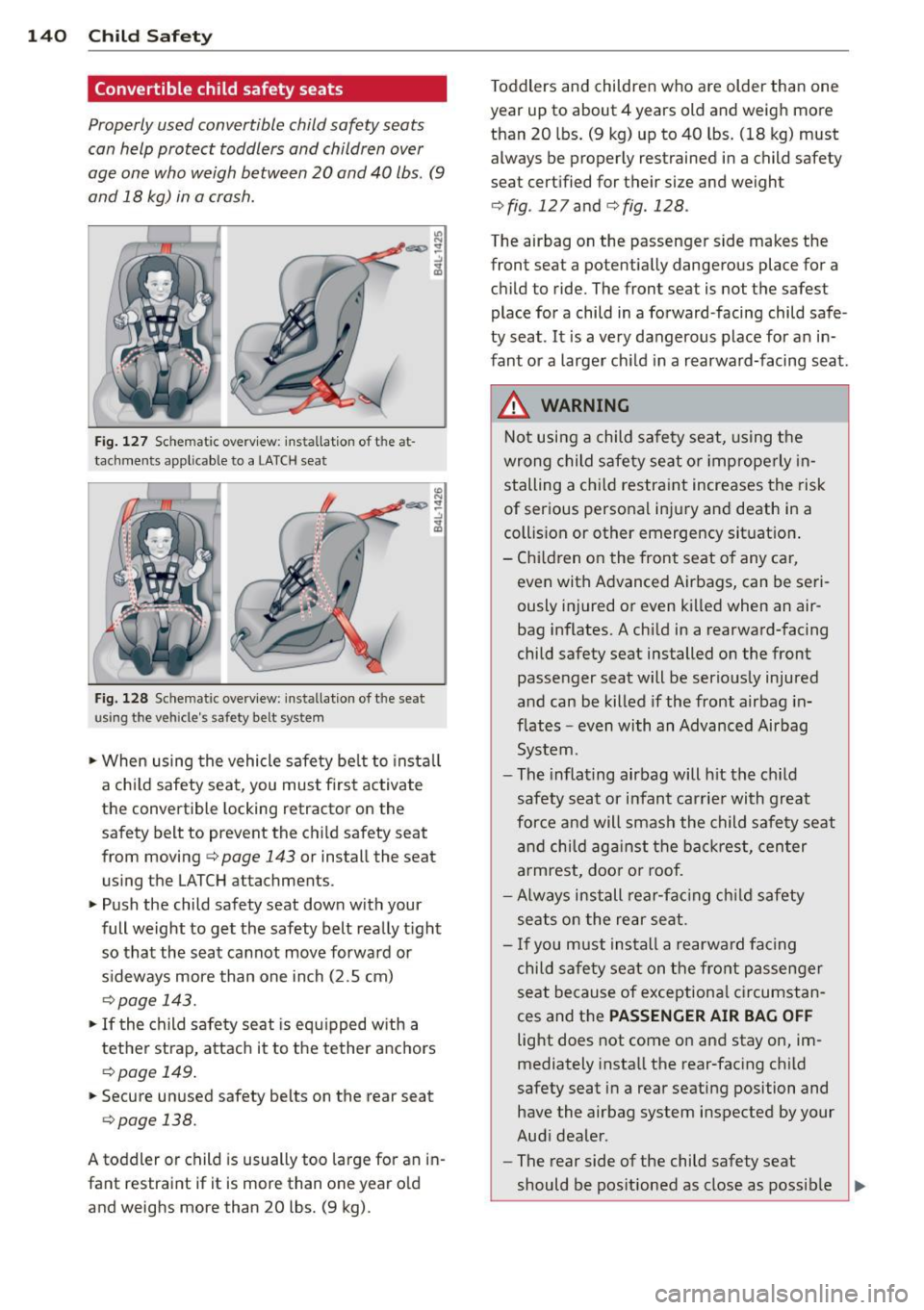
140 Child Safety
Convertible child safety seats
Properly used convertible child safety seats
can help protect toddlers and children over
age one who weigh between
20 and 40 lbs. (9
and 18 kg) in a crash.
Fig. 127 Schematic overv iew : ins tallat ion of t he at
ta chments applicable to a LATCH seat
Fig. 128 Schematic overview: insta llation of th e seat
us ing t he veh icle's safety belt system
.. When using the vehicle safety be lt to install
a child safety seat, you must first activate
the convertible locking retractor on the
safety belt to prevent the child safety seat
from moving
c:> page 143 or install the seat
using the LATCH attachments .
.. Push the child safety seat down with your
full weight to get the safety belt really tight
so that the seat cannot move forward or sideways more than one inch (2.5 cm)
c:>page 143.
.. If the child safety seat is equ ipped with a
tether strap, attach it to the tether anchors
c:> page 149.
.. Secure unused safety belts on the rear seat
c:> page 138.
A toddler or child is usually too large for an in
fant restraint if it is more than one year old
and weighs more than 20 lbs. (9 kg) . Toddlers and
children who are older than one
year up to about 4 years old and weigh more
than 20 lbs. (9 kg) up to 40 lbs. (18 kg) must
always be properly restrained in a child safety
seat certified for their size and weight
c:> fig . 12 7 and c:> fig . 128 .
The airbag on the passenger side makes the
front seat a potentially dangerous place for a
child to ride. The front seat is not the safest
place for a child in a forward -facing child safe
ty seat . It is a very dangerous place for an in
fant or a larger child in a rearward-facing seat.
_&. WARNING
Not using a child safety seat, using the
wrong child safety seat or improp erly in
stalling a child restraint increases the risk
of serious personal injury and death in a
collision or other emergency situation .
- Children on the front seat of any car,
-
even with Advanced Airbags, can be seri
ously injured or even killed when an air bag inflates . A child in a rearward-facing
child safety seat installed on the front passenger seat will be seriously injured
and can be killed if the front airbag in
f la tes -even with an Advanced Airbag
System .
- The inflating airbag will hit the child
safety seat or infant carrier with great
force and will smash the child safety seat
and child against the backrest, center
armrest, door or roof.
- Always install rear-facing child safety
seats on the rear seat .
- If you must install a rearward facing
child safety seat on the front passenger
seat because of exceptiona l circumstan
ces and the
PASSENGER AIR BAG OFF
light does not come on and stay on, im
mediately install the rear-facing child
safety seat in a rear seating position and
have the airbag system inspected by your
Audi dealer.
- The rear side of the child safety seat
should be positioned as close as possible ..,.
Page 143 of 258
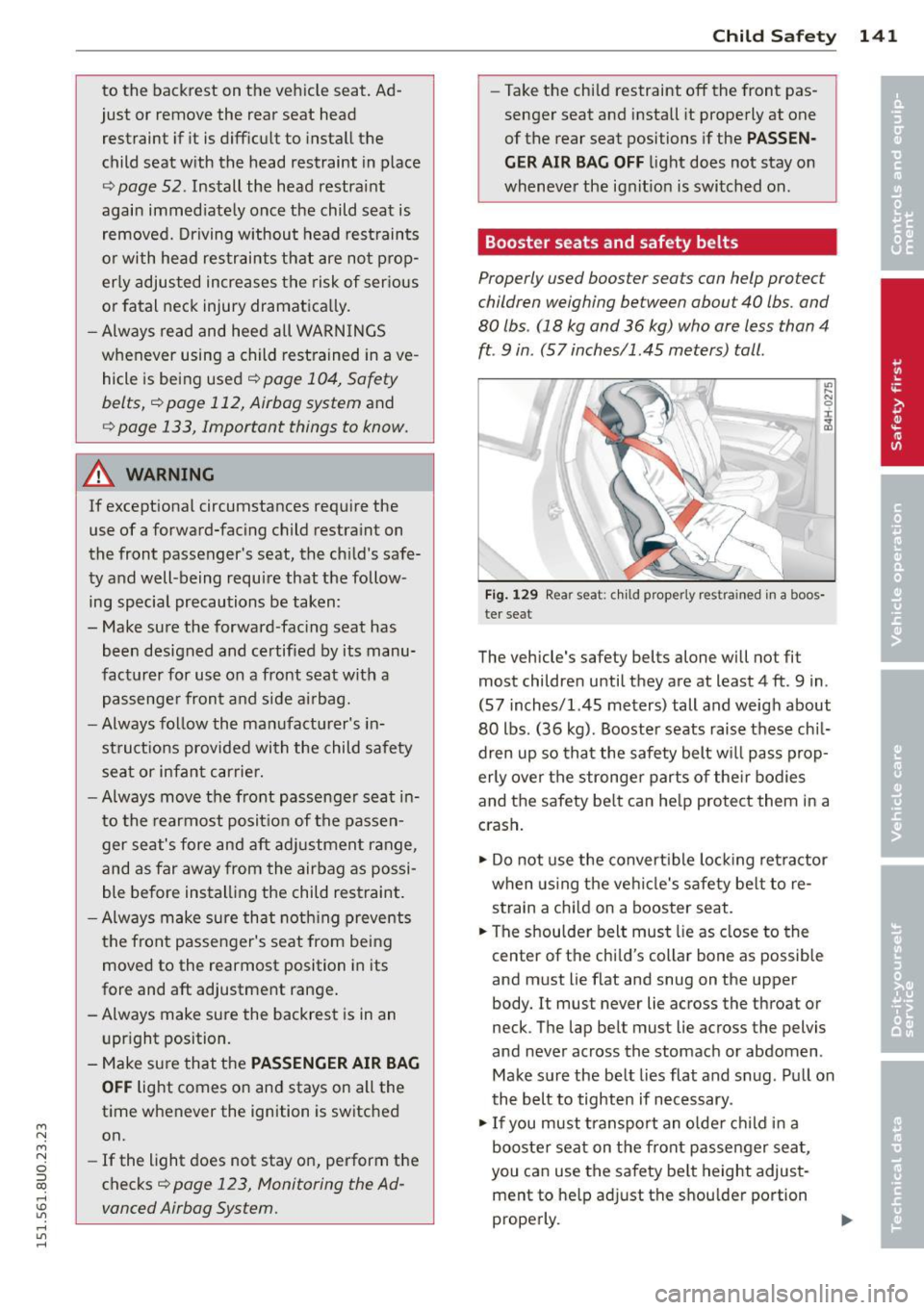
M N M N
0 ::i co
rl I.O
"' rl
"' rl
to the backrest on the vehicle seat. Ad
just or remove the rear seat head restraint if i t is difficult to install the
child seat w ith the head restraint in place
¢ page 52. Install the head restraint
again immed iate ly once the child seat is
removed. Driving without head restraints
o r with head restraints that are not prop
erly adjusted increases the risk of serious
or fatal neck injury dramatically.
- Always read and heed all WARNINGS
whenever using a child rest rained in ave
hicle is being used
¢page 104, Safety
belts,
¢ page 112, Airbag system and
¢ page 133, Important things to know.
A WARNING
If except ional circumstances require the
use of a forward-facing child restraint on
the front passenger's seat, the ch ild's safe
ty and well-being require that the follow
ing special precautions be taken:
- Make sure the forward-fac ing seat has
been designed and certified by its manu
facturer for use on a front seat with a passenge r fron t and side airbag.
- Always follow the manufacturer's in
st ruct ions provided with the child safety
sea t or infan t carrier.
- Always move the front passenge r seat in
to the rearmost posit ion of the passen
ger seat's fore and aft ad justment r ange,
and as far away from the airbag as possi
ble before instal ling the child restraint.
- Always make sure that noth ing prevents
the front passenger's seat from bei ng
moved to the rearmost position in its
fore and aft adjustment range .
- Always make sure the backrest is in an
upright position.
- Make su re that the
PASSENGER AIR BAG
OFF
light comes on and stays on all the
time whenever the ignition is switched
on.
- If the light does not stay on, perform the
checks¢
page 123, Monitoring the Ad
vanced Airbag System.
-
Child S afety 141
-Ta ke the chi ld restraint off the front pas
senger seat and install it properly at one
of the rear seat positions if the
PASSEN
GER AIR BAG OF F
light does not stay on
whenever the ignit ion is switched on.
Booster seats and safety belts
Properly used booster seats con help protect
children weighing between about 40 lbs. and
80 lbs. (18 kg and 36 kg) who are less than 4
ft. 9 in . (57 inches/1 .45 meters) tall.
In .... N 0 ±
~
F ig . 1 29 Rear seat: ch ild properly res trained in a boos
ter seat
The vehicle's safety belts alone will not fit
most children until they are at least 4
ft. 9 in .
(57 inches/1.45 me ters) tall and weigh about
80 lbs . (36 kg) . Booster seats rais e these chi l
dren up so tha t the safety belt w ill pass p rop
erly over the stronger parts of the ir bodies
and the safety be lt can he lp protect them in a
crash.
.,. Do not use the convert ible lo cki ng ret ra ctor
when using the ve hicl e's s afety be lt to re
s train a ch ild on a booster seat.
... The shoulde r belt must lie as close to the
center of the ch ild's collar bone as possible
and must lie flat and snug on the upper
body. It must never lie across the throat or
neck . The lap belt must lie across the pelvis
and never across the stomac h or abdomen .
Make su re the belt lies flat and snug. Pull on
th e belt to tighten if necessary.
.,. If you must transport an o lde r ch ild i n a
booster seat on t he front passenger sea t,
you can use the safety be lt height adjust
ment to help ad just the shou lder portion
prope rly.
Page 144 of 258
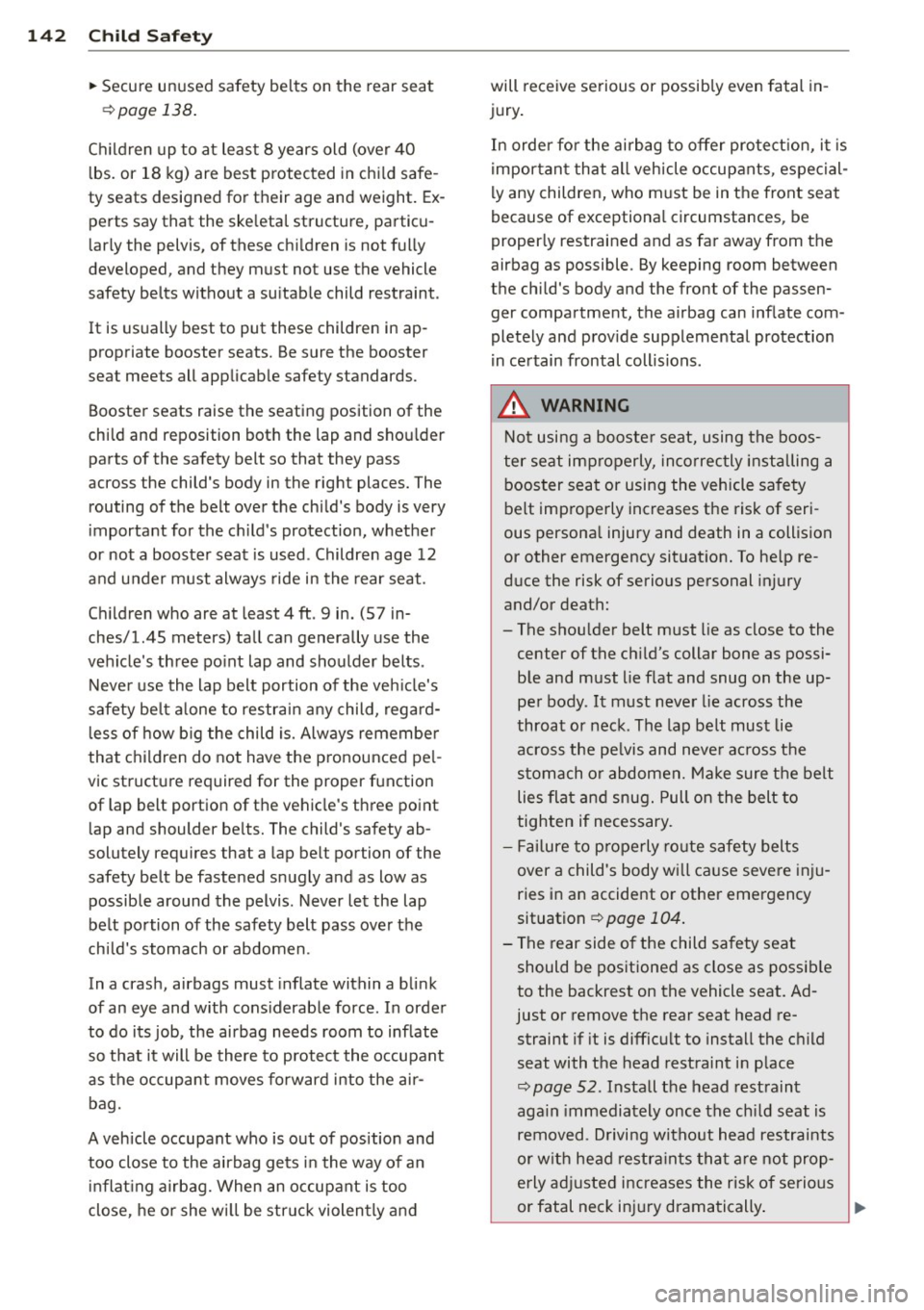
142 Child Saf ety
• Secure unused safety belts on the rear seat
9 page 138 .
Children up to at least 8 years old (over 40
l bs. or 18 kg) are best protected in chi ld safe
ty seats designed for their age and weight. Ex perts say that the ske leta l structure, particu
larly the pelvis, of these chi ldren is not fully
developed, and they must not use the vehicle
safety belts w ithout a su itable child restraint .
It is us ually best to put these children in ap
propriate booster seats. Be sure the booster
seat meets all applicab le safety standards.
Booster seats raise the seating position of the
child and reposition bot h the lap and shou lder
parts of the safety belt so that they pass
across the child 's body in the right places. The
routing of the belt over the child 's body is very
important for the ch ild's protection, whether
or not a booster seat is used . Children age 12
and under must always ride in the rear seat.
Ch ildren who are at least 4
ft . 9 in. (S7 in
ches/1.4S meters) tall can generally use the
vehicle's three po int lap and shoulder be lts .
Neve r use the lap belt portion of the veh icle's
safety be lt alone to restrain any child, regard
l ess of how b ig the child is. Always remembe r
that c hildren do not have the pronounced pe l
vic structure required for the proper function
of lap belt portion of the vehicle's thre e point
lap and shoulder be lts. The child's safety ab
solutely requires that a lap be lt portion of the
safety belt be fastened snugly and as low as
possible around the pelvis . Never let the lap
be lt po rtion of the safety belt pass over the
chi ld's stomach or abdomen.
In a crash, airbags must inflate within a blink
of an eye and with cons iderable force . In order
to do its job, the airbag needs room to inflate
so t hat it will be there to p rotect the occupant
as the occupant moves forw ard into the air
bag.
A vehicle occupant who is out of position and
too close to the airbag gets in the way of an
i n flat ing airb ag. When an occupant is too
close, he or she wi ll be struc k violen tly and will
receive se rious or possib ly even fatal in
jury .
In orde r fo r the ai rb ag to offer protect ion, i t is
i mportan t that a ll vehicle occupants, espe cial
ly any children, who m ust be in the front seat
because of exceptiona l circumstances , be
proper ly restrained and as far away from the
airbag as possible . By keeping room between
the child 's body and the front of the passen
ger compartment, the airbag can inflate com
pletely and prov ide supplemental protection
in certain frontal collisions .
.&, WARNING
Not using a booste r seat, using the boos
ter seat improperly, in co rrectly installing a
boos ter seat or using the vehicle sa fety
belt imp roperly increases the risk of seri
ous persona l injury and death in a collision
or other emergency situat ion. To he lp re
d uce the risk of serio us personal injury
and/or death:
- The shou lder belt must lie as close to the
center of the ch ild's collar bone as possi
b le and must lie flat and snug on the up
per body . It must neve r lie across the
throat or neck . The lap belt must lie
across the pe lvis and neve r ac ross t he
s tomach o r abdomen. Make sure t he belt
liesflat and snug.Pullon thebelt to
tighten if necessary.
- Failure to p roperly ro ute s afe ty belts
over a child's body wi ll ca use seve re inj u
ries in an accident o r other emergency
situation
¢ page 104 .
-The rear side o f the child sa fety seat
should be pos itioned as close as possib le
to the backrest on the vehicle seat. Ad
just or remove the rear seat head re straint if it is diffic ult to install the ch ild
seat with the head restraint in p lace
c::> page 52 . Install t he head rest raint
aga in immediately once the ch ild seat is
removed . D riving without head restraints
or w ith head restra ints th at ar e not prop
erly a djusted increases the risk of serious
.
or fatal neck in jury drama tically . ""
Page 145 of 258
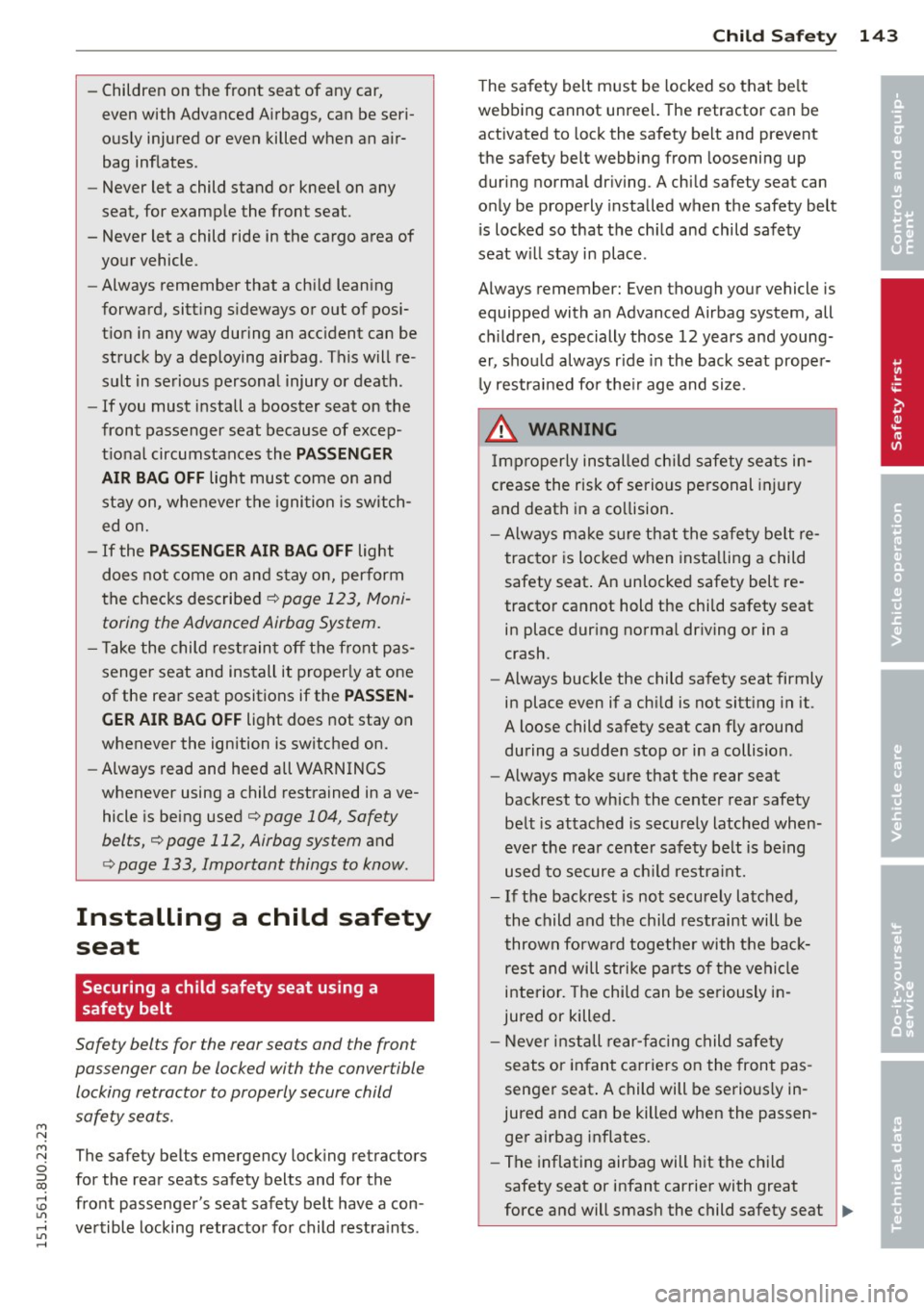
M N
M N
0 ::i co ,...., \!) ..,.,
,...., ..,., ,....,
-Children on the front seat of any car,
even with Advanced A irbags, can be seri
ous ly injured or even killed when an a ir
bag inflates.
- Never let a child stand or kneel on any
seat, for examp le the front seat.
- Never let a child ride in the cargo area of
your vehicle .
- Always remember that a ch ild lean ing
forward, sitt ing sideways or out of posi
t ion in any way during an acc ident can be
struck by a deploying airbag . This will re
sult in se rious personal injury or death .
- If you must install a booster seat on the
front passenger seat because of excep
t ional circumstances the
PASSENGER
AIR BAG OFF
light must come on and
stay on, whenever the ignition is switch
ed on.
- If the
PASSENGER AIR BAG OFF light
does not come on and stay on, perform
the checks described
¢ page 123, Moni
toring the Advanced Airbag System.
- Ta ke the child restrain t off the front pas
senger seat and install it properly at one
of the rear seat positions if the
PASSEN
GER AIR BAG OFF
light does not stay on
whenever the ignition is switched on.
- Always read and heed all WARNINGS
whenever using a child restrained in ave
hicle is being used
¢page 104, Safety
belts,¢ page 112, Airbag system
and
c:> page 133, Important things to know.
Installing a child safety
seat
Securing a child safety seat using a
safety belt
Safety belts for the rear sea ts and the fron t
passenger can be locked wi th the convertible
locking retractor to properly secure child
safety seats .
The safety belts emergency lock ing retractors
for the rear seats safety belts and for the
front passenger's seat safety belt have a con
ve rtible locking retractor for child restraints.
Child Sa fet y 143
The safety belt must be locked so that be lt
webbing cannot unree l. The retractor can be
activated to lock the safety belt and prevent
the safety belt webbing from loosening up
during normal dr iving . A child safety seat can
only be properly installed when the safety belt
i s locked so that the chi ld and child safety
seat w ill stay in place .
Always remember: Even though your vehicle is equipped with an Advanced Airbag system, all
ch ildren, especially those 12 years and young
er, shou ld always r ide in the back seat proper
ly restrai ned fo r the ir age and size.
A WARNING
Improperly installed chi ld safety seats in
crease the risk of serious personal injury
and death in a collision.
- Always ma ke sure that the safety belt re
tracto r is loc ked when installing a child
safety seat . An unlocked safety belt re
tractor cannot hold the child safety seat
in place during normal dr iving or in a
crash.
- Always buckle the child safety seat firmly
in place even if a ch ild is not sitt ing in it.
A loose child safety seat can fly around during a sudden stop or in a collision .
- Always make sure that the rear seat
backrest to which the center rear safety
be lt is attached is securely latched when
eve r the rea r center safety belt is being
used to secure a ch ild restra int.
- If the backrest is not securely latched,
the child and the child restraint will be
thrown forward together with the back rest and will strike parts of the vehicle
interior. The child can be seriously in
jured or killed.
- Never install rear-fa cing child safety
seats or infant carrie rs on the front pas
senger seat . A child will be serio usly in
jured and can be killed when the passen ger airbag inflates.
- The inflating airbag will h it the ch ild
safety seat or infant carrier with great
force and will smash the child safety seat
~
•
•
Page 146 of 258
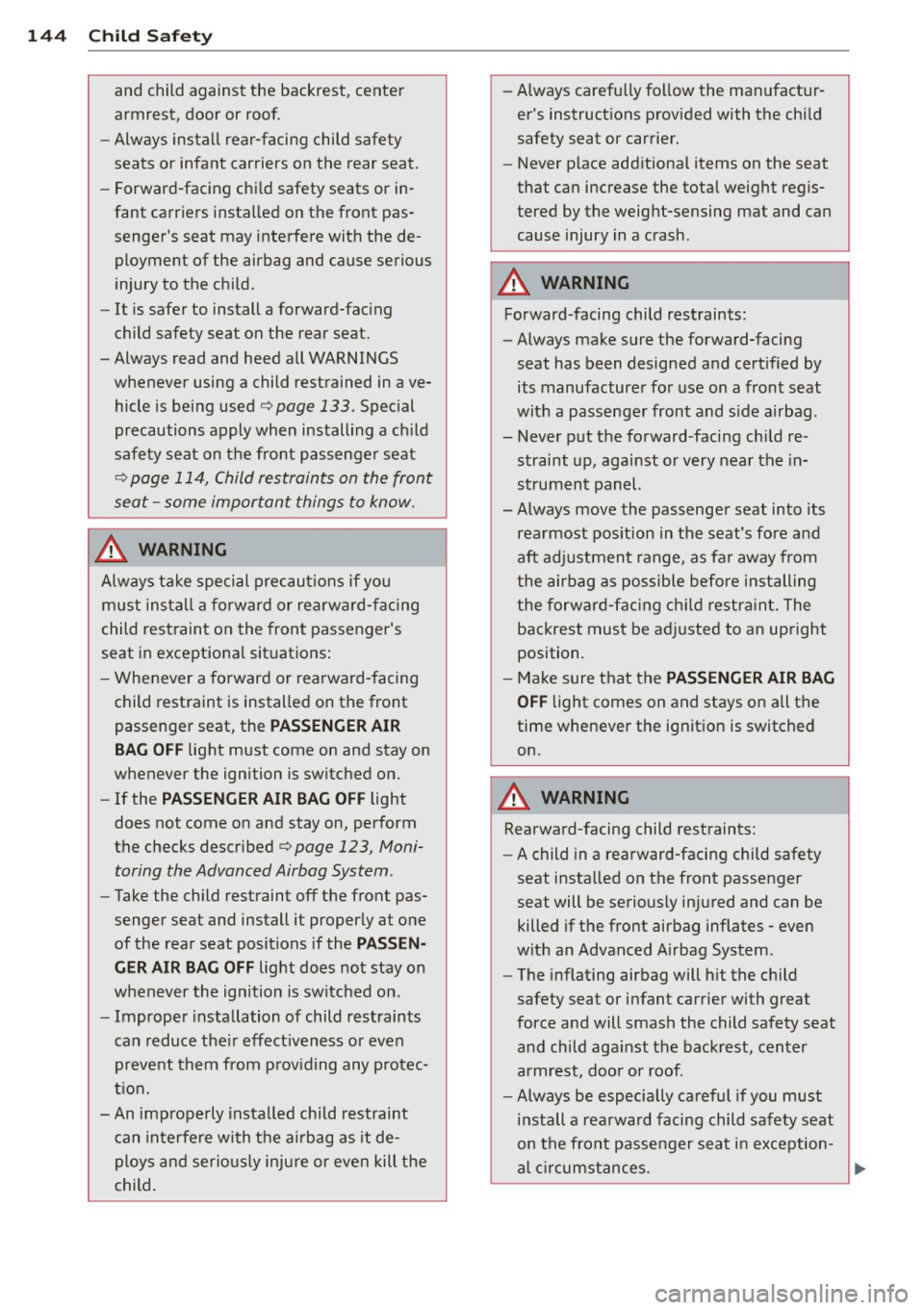
144 Child Safety
and child against the backrest, center
armrest, door or roof.
- Always install rear-facing child safety
seats or infant carriers on the rear seat.
- Forward-facing child safety seats or in
fant carriers installed on the front pas
senger's seat may interfere with the de
ployment of the airbag and cause serious
injury to the child.
- It is safer to install a forward-facing
child safety seat on the rear seat.
- Always read and heed all WARNINGS whenever using a child restrained in ave
hicle is being used
c;,page 133. Special
precautions apply when installing a child
safety seat on the front passenger seat
¢ page 114, Child restraints on the front
seat -some important things to know.
A WARNING
Always take special precautions if you
must install a forward or rearward-facing
child restraint on the front passenger's
seat in exceptional situations:
- Whenever a forward or rearward-facing
child restraint is installed on the front
passenger seat, the
PASSENGER AIR
BAG OFF
light must come on and stay on
whenever the ignition is switched on.
- If the
PASSENGER AIR BAG OFF light
does not come on and stay on, perform
the checks described
c;, page 123, Moni
toring the Advanced Airbag System.
- Take the child restraint off the front pas
senger seat and install it properly at one
of the rear seat positions if the
PASSEN
GER AIR BAG OFF
light does not stay on
whenever the ignition is switched on.
- Improper installation of child restraints
can reduce their effectiveness or even
prevent them from providing any protec
tion.
- An improperly installed child restraint
can interfere with the airbag as it de
ploys and seriously injure or even kill the
child. -
Always carefully follow the manufactur
er's instructions provided with the child
safety seat or carrier.
- Never place additional items on the seat
that can increase the total weight regis
tered by the weight-sensing mat and can
cause injury in a crash .
A WARNING
-Forward-facing child restraints:
- Always make sure the forward-facing
seat has been designed and certified by its manufacturer for use on a front seat
with a passenger front and side airbag .
- Never put the forward-facing child re straint up, against or very near the in
strument panel.
- Always move the passenger seat into its
rearmost position in the seat's fore and
aft adjustment range, as far away from
the airbag as possible before installing
the forward-facing child restraint. The
backrest must be adjusted to an upright
position.
- Make sure that the PASSENGER AIR BAG
OFF
light comes on and stays on all the
time whenever the ignition is switched
on .
A WARNING
Rearward-facing child restraints:
- A child in a rearward-facing child safety
seat installed on the front passenger
seat will be seriously injured and can be killed if the front airbag inflates -even
with an Advanced Airbag System .
- The inflating airbag will hit the child
safety seat or infant carrier with great
force and will smash the child safety seat
and child against the backrest, center
armrest, door or roof.
- Always be especially careful if you must
install a rearward facing child safety seat
on the front passenger seat in exception-
al circumstances.
~
Page 147 of 258
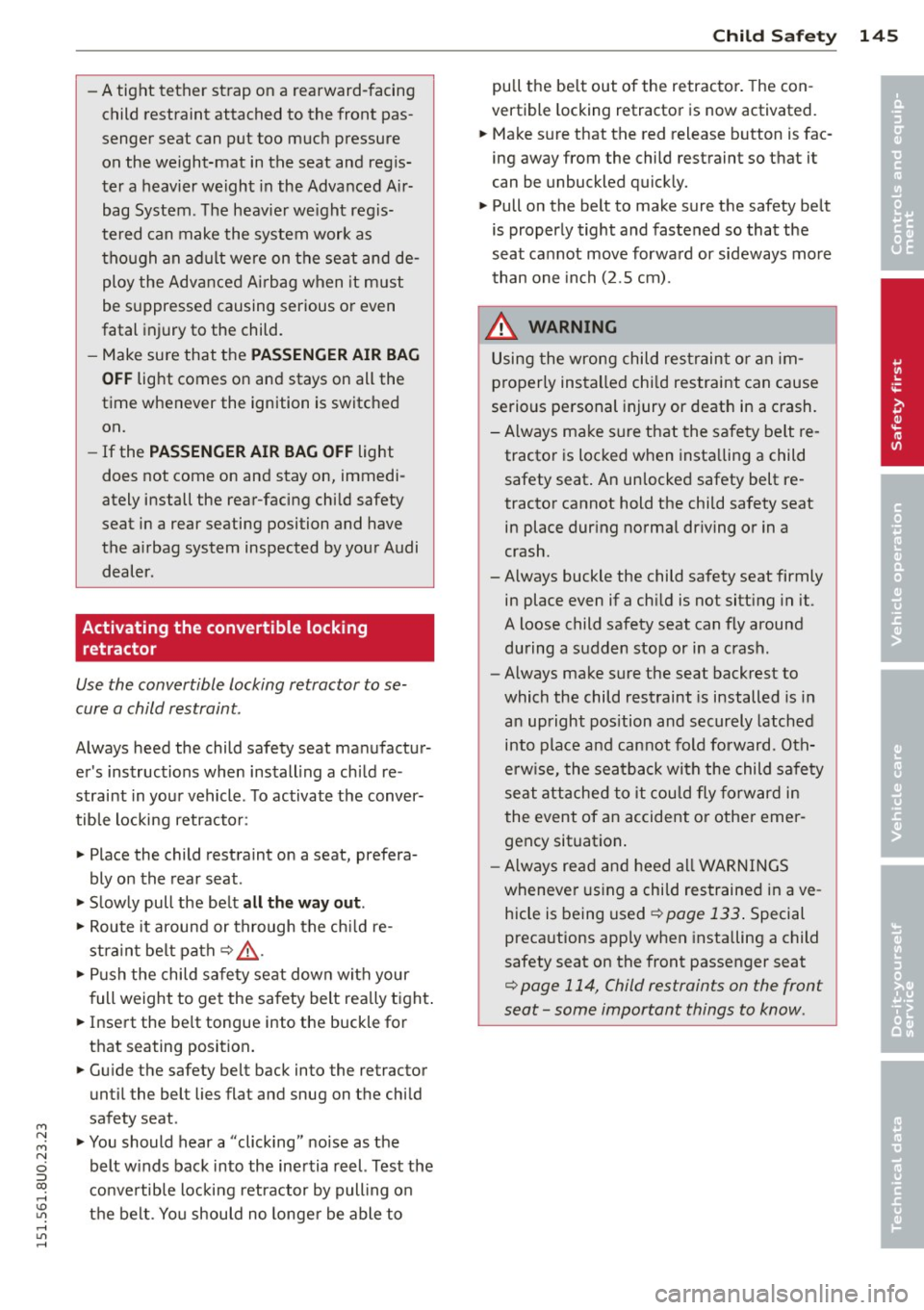
M N
M N
0 ::i co ,...., \!) 1.1'1 ,...., 1.1'1 ,....,
-A tight tether strap on a rearward-facing
child restraint attached to the front pas
senger seat can put too much pressure on the weight-mat in the seat and regis
ter a heavier weight in the Advanced Air
bag System . The heavier weight regis
tered can make the system work as
though an adult were on the seat and de
ploy the Advanced Airbag when it must
be suppressed causing serious or even
fatal injury to the child .
- Make sure that the
PASSENGER AIR BAG
OFF
light comes on and stays on all the
time whenever the ignition is switched
on.
- If the
PASSENGER AIR BAG OFF light
does not come on and stay on, immedi
ately install the rear-facing child safety
seat in a rear seating position and have
the airbag system inspected by your Audi dealer.
Activating the convertible locking
retractor
Use the convertible locking retractor to se
cure a child restraint.
Always heed the child safety seat manufactur
er's instructions when installing a child re
straint in your vehicle . To activate the conver
tible locking retractor :
.. Place the child restraint on a seat, prefera
bly on the rear seat.
.. Slowly pull the belt
all the way out .
.. Route it around or through the child re
straint belt path~&_ .
.. Push the child safety seat down with your
full weight to get the safety belt really tight.
.. Insert the belt tongue into the buckle for
that seating position .
.. Guide the safety belt back into the retractor
until the belt lies flat and snug on the child
safety seat .
.. You should hear a "clicking " noise as the
belt winds back into the inertia reel. Test the
convertible locking retractor by pulling on
the belt . You should no longer be able to
Child Safety 145
pull the belt out of the retractor. The con
vertible locking retractor is now activated.
.. Make sure that the red release button is fac
ing away from the child restraint so that it
can be unbuckled quickly.
.. Pull on the belt to make sure the safety belt
is properly tight and fastened so that the
seat cannot move forward or sideways more
than one inch (2.5 cm).
_&. WARNING
Using the wrong child restraint or an im
properly installed child restraint can cause
serious personal injury or death in a crash.
- Always make sure that the safety belt re-
tractor is locked when installing a child
safety seat. An unlocked safety belt re
tractor cannot hold the child safety seat
in place during normal driving or in a
crash.
-Always buckle the child safety seat firmly in place even if a child is not sitting in it.
A loose child safety seat can fly around
during a sudden stop or in a crash.
- Always make sure the seat backrest to
which the child restraint is installed is in
an upright position and securely latched
into place and cannot fold forward . Oth
erwise, the seatback with the child safety
seat attached to it could fly forward in
the event of an accident or other emer
gency situation .
- Always read and heed all WARNINGS
whenever using a child restrained in ave
hicle is being used¢
page 133. Special
precautions apply when installing a child
safety seat on the front passenger seat
¢ page 114, Child restraints on the front
seat -some important things to know .
-
•
•
Page 148 of 258
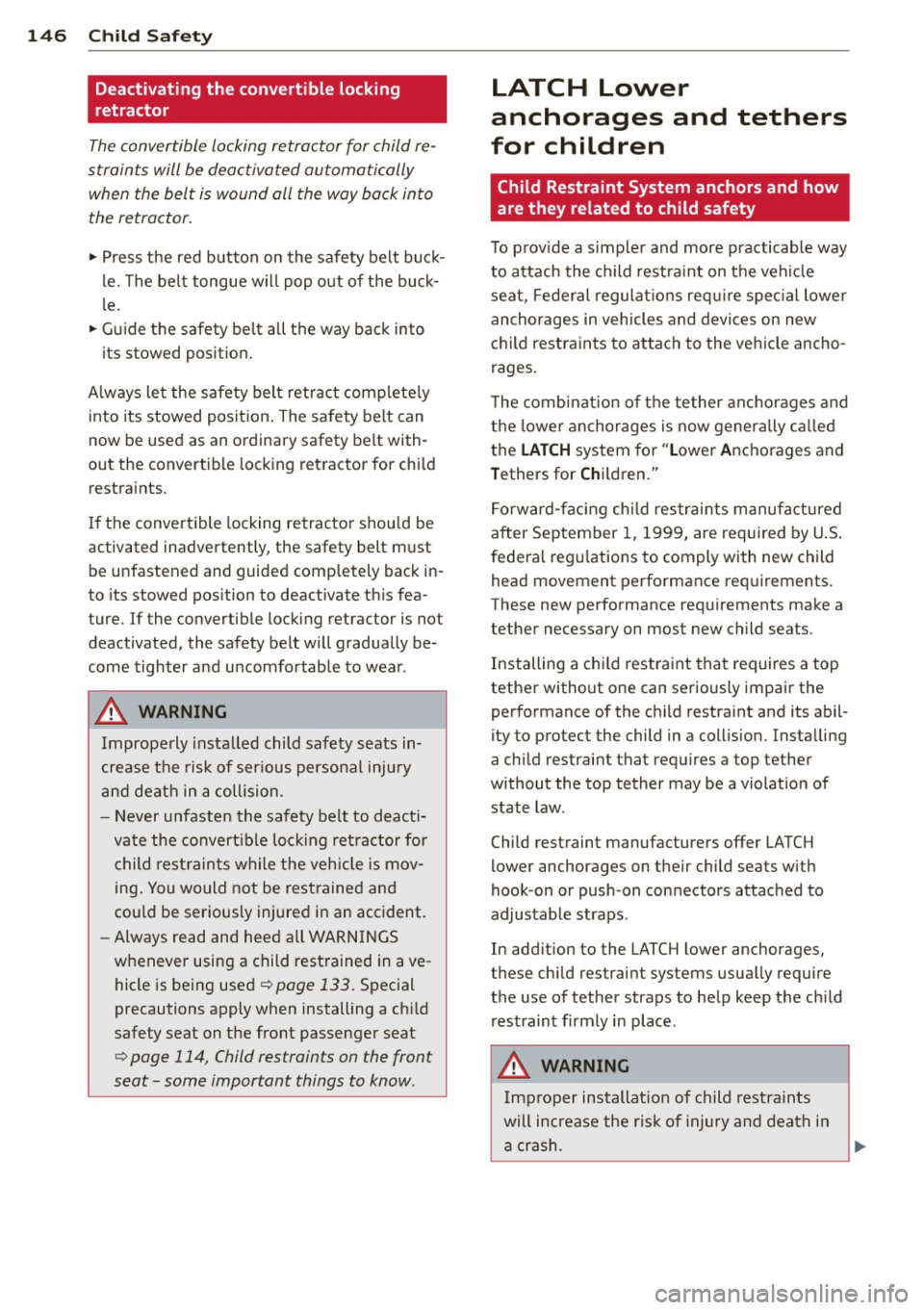
146 Child Saf ety
Deactivating the convertible locking
retractor
The convertible locking retractor for child re
straints will be deactivated automatically when the belt is wound all the way back into the retractor .
.,. Press the red button on the safe ty belt buck
le. The be lt tongue w ill pop out of the buck
le .
.. Guide the safety be lt all the way back into
its stowed position .
A lways le t the safety bel t retract comp lete ly
into its stowed posit ion . The sa fety belt can
now be used as an ordinary safety belt with
out the convert ib le locking ret ractor for chi ld
restra ints.
If the convertible locking retracto r shou ld be
activated inadvertently, the safety belt m ust
be unfastened and guided comp letely back in
to its stowed pos ition to deactivate th is fea
ture. If the convertib le locki ng retractor is not
deactivated, the safety be lt will gradually be
come tighter a nd u ncomfo rtable to wea r.
A WARNING
Imprope rly insta lled child saf ety seats in
crease t he risk of ser ious personal inju ry
a n d death in a collision .
- Never unfaste n the safety belt to deacti
vate the convert ible lo cking re tr actor fo r
ch ild rest rain ts while the veh icle is mov
ing. You would not be res trained and
cou ld be seriously injured in an accident.
- Always re ad and heed all WARN INGS
whenever using a child rest rained in ave
hicle is being used
¢page 133. Special
precautions apply when installing a ch ild
safety seat on the front passenge r seat
¢ page 114, Child restraints on the front
seat -some important things to know.
LATCH Lower
anchorages and tethers
for children
Child Restraint System anchors and how
are they related to child safety
T o p rov ide a simple r and more practicable way
to a ttach the child restra int on t he vehi cle
sea t, Federal regulat ions re quire spe cial lowe r
anchorages in vehicles and devices on new
c h ild restraints to attach to the vehicle ancho
rages.
T he comb inat io n of th e tether anc horages and
the lowe r anchorages is now genera lly c alled
t h e
LATCH system fo r "Lower Anchorages and
T ethers for Child ren."
F o rward-f ac ing ch ild res trai nts ma nufacture d
after September 1, 1999, are req uired by U .S .
f ede ra l regu lations to comply with new child
head movement performance req uirements.
These new performance req uirements make a
tether necessary on most new child seats.
Installing a child restraint that requires a top
tethe r without one can seriously impair the
performance of the c hild restra int and its abil
ity to protect the child in a coll is ion. Insta lling
a chi ld restrai nt that requires a top tether
without the top tether may be a violat ion of
state law.
Child rest raint manufacturers offer LATCH
lower anchorages on their child seats w ith
hook-on or push-on connectors attached to
adjustable straps .
In add ition to the LATCH lower anchorages,
t h ese chi ld restraint systems usually require
t h e use of tethe r straps to he lp keep the ch ild
rest raint fi rmly in place.
A WARNING
-Imp roper installat ion of ch ild restra ints
will i ncrease the r is k of injury a nd dea th i n
a cr ash.
-
Page 149 of 258
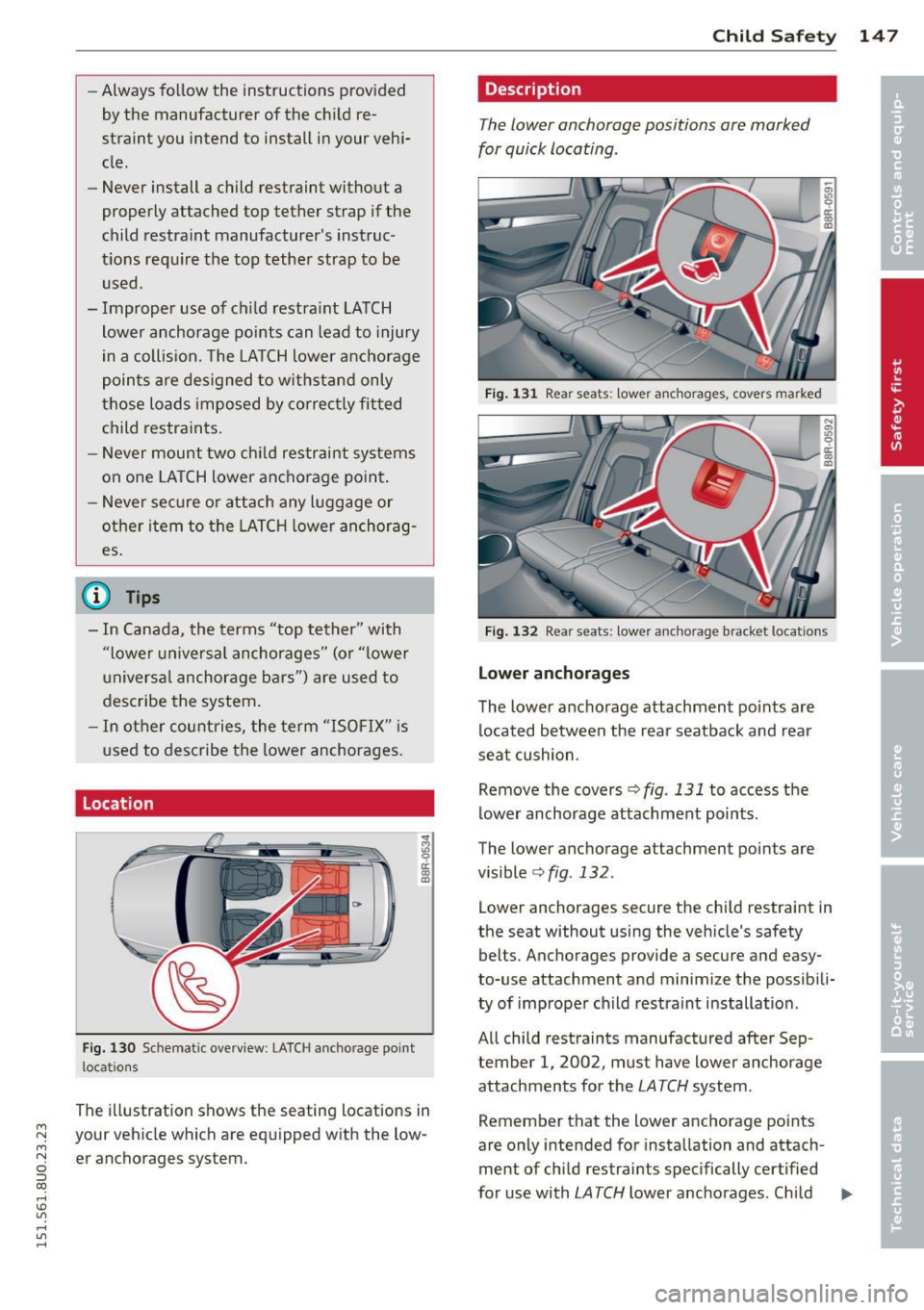
M N M N
0 ::i co
rl I.O
"' rl
"' rl
-Always follow the instructions provided
by the manufacturer of the child re
straint you intend to install in your vehi
cle .
- Never install a child restraint without a
properly attached top tether strap if the
child restraint manufacturer's instruc
t ions req uire the top tether strap to be
used.
- Improper use of child restra int LATCH
lower anchorage po ints can lead to injury
in a collis ion. The LA TCH lower anchorage
poin ts are designed to w ithstand only
those loads imposed by correct ly fit ted
child restraints.
- Never mount two chi ld restraint systems
on one LA TCH lower anchorage point .
- Never secure o r attach any l uggage or
other i tem to the LATC H lower anchorag
es .
{i) Tips
-In Canada, the terms "top tether" with
"lowe r universa l anchorages" (or "lower
universa l anchorage bars") are used to
desc ribe the system .
- In ot her countries, the term "ISOFIX" is
u sed to describe the lower anchorages.
Location
F ig. 130 Schematic overview : LATCH anc horage point
locations
The ill ustration shows the seating locations in
your vehicle which are equipped with the low
er anchorages system.
Child S afety 14 7
Description
The lower anchorage positions are marked
for quick locating .
Fig . 1 31 Rear seats : lower anchorages, covers marked
Fig. 132 Rea r seats: lower ancho rage bracket locations
Low er anchorag es
The lower anc ho rage attachment po ints are
located between the rea r seatback and rear
seat cushion .
Remove the covers
c';> fig . 131 to access the
lower anchorage attachment points .
The lower anchorage attachment points are
visible ¢
fig. 132 .
Lower anchorages secure the chi ld restraint in
the seat without using the vehicle's safety
belts . Anchorages provide a secure and easy
to-use attachment and minimize the possib ili
ty of improper child restra int installation .
All child restraints manufactured after Sep
tember 1, 2002, must have lower anchorage
attachments for the
LATCH system.
Remember that the lower anchorage points
are only intended for insta llation and attach
ment of child restraints specifically certified
for use with
LATCH lower anchorages. Child .,..
Page 150 of 258
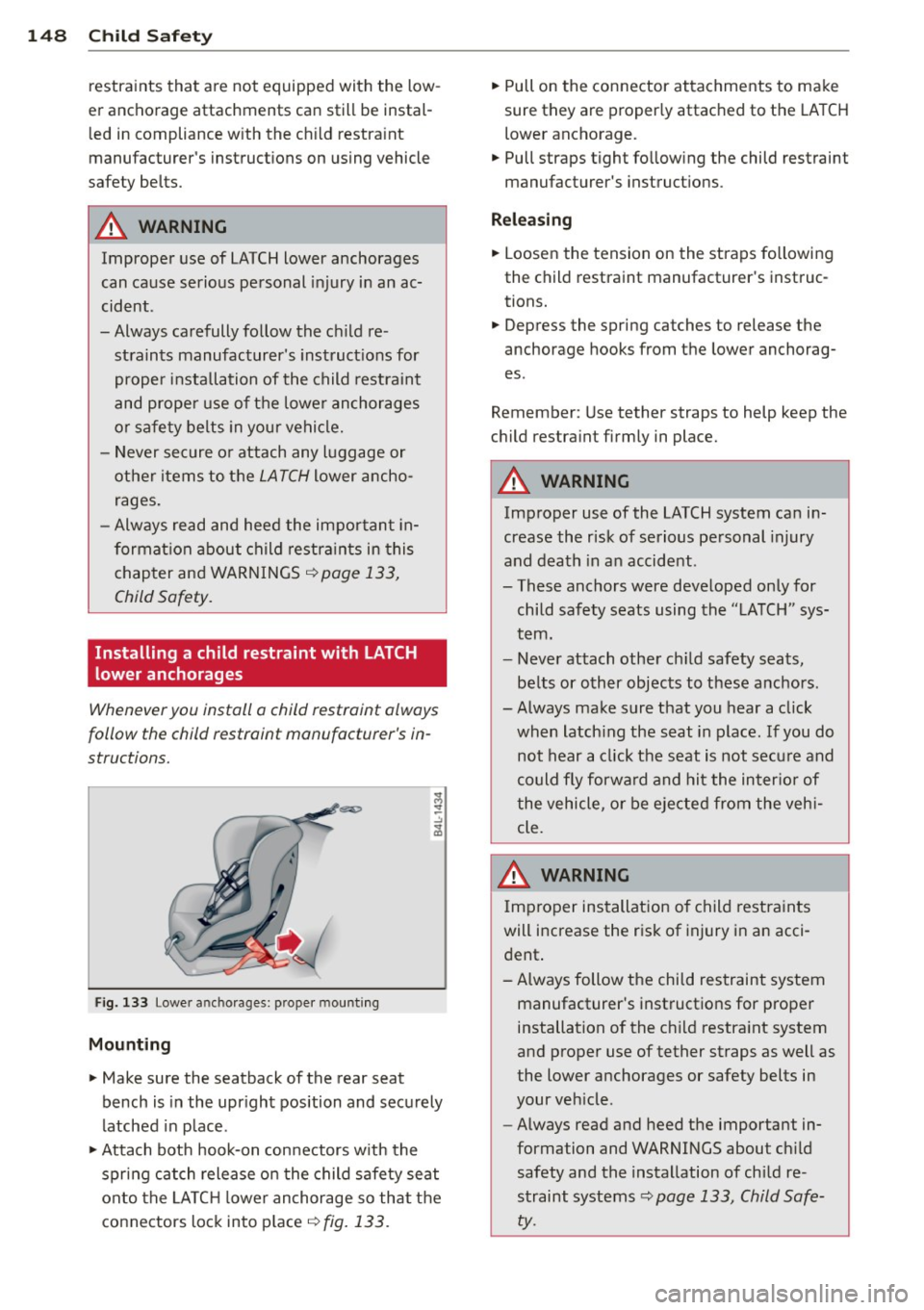
148 Child Saf ety
restraints that are not equipped with the low
er anchorage attachments can still be instal l ed in compliance w ith the ch ild restra int
manufacturer's instruct ions on using vehicle
safety belts.
.&_ WARNING
Improper use of LATCH lower anchorages
can ca use serio us pe rsonal injury i n an ac
cident .
-Always carefully follow the c hild re
st raints manufacturer's inst ruct ions for
prope r in stallation of the child rest ra int
and proper use of t he lowe r an chorages
or sa fe ty belts in you r ve hicle.
- Never se cure o r attach any l uggage or
ot he r items to t he
LATCH lower ancho
rages.
- Always read and heed the im por tan t in
f ormat ion a bout child restr aints in this
chapter and WARNINGS
q page 133,
Child Safety.
Installing a child restraint with LATCH
lower anchorages
Whenever you install a child restraint always
follow the child restraint manufacturer's in
structions.
Fi g. 13 3 Lower a nch orages: p rope r m ount ing
Mounting
• Make sure the seatback of the rear seat
bench is in the upr ight position and securely
latched in place .
• Attach both hook -on con nectors w ith the
spring cat ch relea se on the child safety se at
onto the LATC H lowe r anchorage so that the
connectors lock into p lace
q fig. 133.
•Pullon the connector attachments to make
sure they are properly attached to the LA T CH
lower anchorage.
• Pull straps t ight fo llow ing the child restraint
manufacturer's instruct ions .
Releasing
• Loosen the tension on the straps following
the child restraint manufacturer 's instruc
tions.
• Depress the spring catches to release the
anchorage hooks from the lower anchorag
es .
Remember: Use tether straps to help keep the
c h ild restra int firmly in place.
.&_ WARNING
=
Imp roper use of the LATCH system can i n-
crease the r isk of serious pe rsonal injury
and death in a n accident .
- These anchors were deve loped only for
child safety seats using the "L ATCH" sys
t e m.
- Never attach othe r ch ild safety sea ts,
be lts or other objects to these anchors .
- Always make sure that you hear a click
when latch ing the seat in place .
If you do
not hear a click the seat is not secu re and
could fly forwa rd and hit the inter ior of
the vehicle, o r be e je ct ed from the veh i
cle .
.&_ WARNING
=
I mp roper ins tallat ion of child restra ints
will increase the r isk of injury in an acci
dent .
- Always follow t he child res traint system
manufacturer's inst ruct ions for proper
installation of the c hild restra int system
and proper use of tether straps as well as
the lower anchorages or safety belts in
your ve hicle.
- Always read and heed the important in
formation and WARNINGS about ch ild
safety and the installation of ch ild re
straint systems
q page 133, Child Safe
ty .